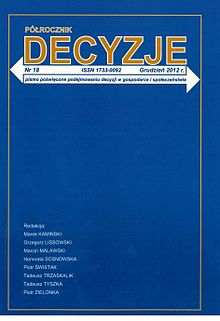Dowodzenie hipotez za pomocą czynnika bayesowskiego (bayes factor): przykłady użycia w badaniach empirycznych
WEIGHING EVIDENCE IN FAVOUR OF RESEARCH HYPOTHESES USING BAYES FACTOR: EXAMPLES OF APPLICATION IN EMPIRICAL STUDIES
Author(s): Artur Domurat, Michał BiałekSubject(s): Economy
Published by: Akademia Leona Koźmińskiego
Keywords: statistical inference; null hypothesis testing; Bayes Factor; p-value; Bayes’ rule
Summary/Abstract: Statistical tests are used in science in order to support research hypotheses (theory, model). The Bayes Factor (BF) is a method that weighs evidence and shows which out of two hypotheses is better supported. Adopting the BF in statistical inference, we can show whether data provided stronger support for the null hypothesis, the alternative hypothesis or whether it is inconclusive and more data needs to be collected to provide more decisive evidence. Such a symmetry in interpretation is an advantage of the Bayes Factor over classical null hypothesis signifi cance testing (NHST). Using NHST, a researcher draws conclusions indirectly, by rejecting or not rejecting the null hypothesis. The discrepancy between these decisions and the researcher’s needs, often leads to misinterpretation of signifi cance test results, e.g. by concluding that non-signifi cant p-values are evidence for the absence of differences between groups or that variables are independent. In this work we show the main differences between the Bayesian and the frequential approach to the understanding of probability and statistical inference. We demonstrate how to verify hypotheses using the BF in practice and provide concrete examples of how it modifi es conclusions about empirical findings based on the NHST procedure and the interpretation of p-values. We discuss the advantages of the BF – particularly the validation of a null hypothesis. Additionally, we provide some guidelines on how to do Bayesian statistics using the freeware statistical program JASP 0.8.
Journal: Decyzje
- Issue Year: 2016
- Issue No: 26
- Page Range: 109-141
- Page Count: 33
- Language: Polish

